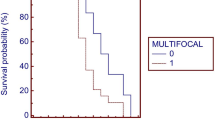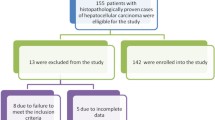Abstract
Purpose
There is a growing evidence showing that there are geographic differences in hepatocellular carcinoma (HCC). Little is known about the characteristics of hepatocellular carcinoma in the Arabian Peninsula. The present study examines the presentation and outcomes of HCC in a single institution.
Methods
A retrospective chart review of patients presented with advanced-stage HCC to Kuwait Cancer Control Center (KCCC) between 2008 and 2018 was conducted. Data collected included patients demographics, HCC risk factors, performance status, Child-Pugh score, pick up of sorafenib, and survival.
Results
About 111 cases were analyzed. The mean age of the cohort was 61.8 ± 11.4 years and 94 patients (84.7%) were males. HCV and diabetes were the most common risk factors for HCC and presented in 60 patients (54.1%) and 45 patients (40.5%), respectively. About 78 (70.3%) patients had an Eastern Cooperative Oncology Group (ECOG) performance status of 0–1 at presentation. Only 29 (26.1%) patients presented with Child-Pugh class A, while 42 (40.4%) patients received sorafenib. The median overall survival was only 3 months.
Conclusions
In our cohort, HCV and diabetes were the main risk factors for HCC. The majority of patients was not amenable to sorafenib treatment and carries a very poor prognosis.

Similar content being viewed by others
Abbreviations
- GCC :
-
Gulf Cooperation Council
- HCC :
-
hepatocellular carcinoma
- KCCC :
-
Kuwait Cancer Control Center
- PS :
-
performance status
- RFA :
-
radiofrequency ablation (RFA)
- TACE :
-
transarterial chemoembolization
References
Parkin DM, Bray F, Ferlay J, Pisani P. Global cancer statistics, 2002. CA Cancer J Clin. 2005;55(2):74–108.
Parkin DM. Global cancer statistics in the year 2000. Lancet Oncol. 2001;2(9):533–43.
Rasul KI, Al-Azawi SH, Chandra P, Abou-Alfa GK, Knuth A. Status of hepatocellular carcinoma in Gulf region. Chin Clin Oncol. 2013;2(4).
Takayama T, Makuuchi M, Kojiro M, Lauwers GY, Adams RB, Wilson SR, et al. Early hepatocellular carcinoma: pathology, imaging, and therapy. Ann Surg Oncol. 2008;15(4):972–8.
Fukuda R, Ishimura N, Niigaki M, Hamamoto S, Satoh S, Tanaka S, et al. Serologically silent hepatitis B virus coinfection in patients with hepatitis C virus-associated chronic liver disease: clinical and virological significance. J Med Virol. 1999;58(3):201–7.
Parkin DM. The global health burden of infection-associated cancers in the year 2002. Int J Cancer. 2006;118(12):3030–44.
Ezzat S, Abdel-Hamid M, Eissa SA-L, Mokhtar N, Labib NA, El-Ghorory L, et al. Associations of pesticides, HCV, HBV, and hepatocellular carcinoma in Egypt. Int J Hyg Environ Health. 2005;208(5):329–39.
El-Sayed H, Abaza S, Mehanna S, Winch PJ. The prevalence of hepatitis B and C infections among immigrants to a newly reclaimed area endemic for Schistosoma mansoni in Sinai. Egypt Acta Trop. 1997;68(2):229–37.
Fakeeh M, Zaki AM. Hepatitis C: prevalence and common genotypes among ethnic groups in Jeddah, Saudi Arabia. Am J Trop Med Hyg. 1999;61(6):889–92.
Baffy G. 2012 hepatocellular carcinoma in type 2 diabetes: more than meets the eye. Nature Publishing Group.
Salmon D, Bani-Sadr F, Loko M-A, Stitou H, Gervais A, Durant J, et al. Insulin resistance is associated with a higher risk of hepatocellular carcinoma in cirrhotic HIV/HCV-co-infected patients: results from ANRS CO13 HEPAVIH. J Hepatol. 2012;56(4):862–8.
Wang P, Kang D, Cao W, Wang Y, Liu Z. Diabetes mellitus and risk of hepatocellular carcinoma: a systematic review and meta-analysis. Diabetes Metab Res Rev. 2012;28(2):109–22.
Wang Y-G, Wang P, Wang B, Fu Z-J, Zhao W-J, Yan S-L. Diabetes mellitus and poorer prognosis in hepatocellular carcinoma: a systematic review and meta-analysis. mn PLoS One. 2014;9(5):e95485.
Qian G-S, Ross RK, Yu MC, Yuan J-M, Gao Y-T, Henderson BE, et al. A follow-up study of urinary markers of aflatoxin exposure and liver cancer risk in Shanghai, People’s Republic of China. Cancer Epidemiol Biomarkers Prev. 1994;3(1):3–10.
Yu M-W, Yang Y-C, Yang S-Y, Cheng S-W, Liaw Y-F, Lin S-M, et al. Hormonal markers and hepatitis B virus-related hepatocellular carcinoma risk: a nested case–control study among men. J Natl Cancer Inst. 2001;93(21):1644–51.
Poustchi H, Sepanlou SG, Esmaili S, Mehrabi N, Ansarymoghadam A. Hepatocellular carcinoma in the world and the Middle East. Middle East J Dig Dis. 2010;2(1):31.
Zavaglia C, De Carlis L, Alberti AB, Minola E, Belli LS, Slim AO, et al. Predictors of long-term survival after liver transplantation for hepatocellular carcinoma. Am J Gastroenterol. 2005;100(12):2708.
Wayne JD, Lauwers GY, Ikai I, Doherty DA, Belghiti J, Yamaoka Y, et al. Preoperative predictors of survival after resection of small hepatocellular carcinomas. Ann Surg. 2002;235(5):722.
Natsuizaka M, Omura T, Akaike T, Kuwata Y, Yamazaki K, Sato T, et al. Clinical features of hepatocellular carcinoma with extrahepatic metastases. J Gastroenterol Hepatol. 2005;20(11):1781–7.
Wu Q, Qin S-K. Features and treatment options of Chinese hepatocellular carcinoma. Chin Clin Oncol. 2013;2(4).
Cheng A-L, Kang Y-K, Chen Z, Tsao C-J, Qin S, Kim JS, et al. Efficacy and safety of sorafenib in patients in the Asia-Pacific region with advanced hepatocellular carcinoma: a phase III randomised, double-blind, placebo-controlled trial. Lancet Oncol. 2009;10(1):25–34.
Acknowledgments
The authors acknowledge the efforts of the file section department for their sincere cooperation.
Author information
Authors and Affiliations
Contributions
Dr. Jasem Albarrak developed the original idea, wrote the protocol, and contributed to study design and critical revision of the manuscript. Dr. Amrou Shaaban abstracted and analyzed the data and wrote the manuscript. Dr. Rashad Salama, Dr. Asit, and Dr. Youssif collected data and fill the study proforma.
Corresponding author
Additional information
Publisher’s Note
Springer Nature remains neutral with regard to jurisdictional claims in published maps and institutional affiliations.
Rights and permissions
About this article
Cite this article
Shaaban, A., Salamah, R., Abo Elseud, Y. et al. Presentation and Outcomes of Hepatocellular Carcinoma in the Arabian Peninsula: A Review of a Single Institution Experience in the Sorafenib Era. J Gastrointest Canc 52, 85–89 (2021). https://doi.org/10.1007/s12029-019-00341-7
Published:
Issue Date:
DOI: https://doi.org/10.1007/s12029-019-00341-7




